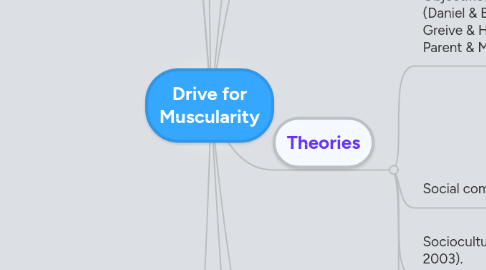
1. Behaviours
1.1. Supplement use (Chittester & Hausenblas, 2009; Parent, 2011)
1.2. Steroid use (Parent, 2011)
1.3. Body Surveillance (Daniel & Bridges, 2010)
1.4. Overtraining syndrome (OTS) (Parent, 2011; Halson & Jeukendrup, 2004)
1.4.1. Lowered immune functioning, mood state alterations, decreased physical and sport performance.
1.5. Exercise dependence (Chittester & Hausenblas, 2009)
2. Future Research
2.1. The role weightlifting plays in the DFM
2.2. Examine the effect of positive and negative beliefs on decisions to use PES's using longitudinal or experimental designs.
2.3. Examine the Muscularity oriented body image (MBI) subscale of the DFM scale's predictive validity of psychological outcomes associated with the DFM.
2.4. Identify outcomes that are linked specifically to the Muscularity oriented body image (MBI) and Muscularity behavior (MB) subscales.
2.5. Examine if the DFM is malleable. E.g., can a group low in DFM increase their scores?
2.5.1. Current body size perception in males is malleable and susceptible to social influences.
2.6. Antecedents and consequences of the DFM
2.7. Individual differences between those high in the DFM and those low in the DFM.
2.8. DFM relationship to performance enhancing substance use.
2.9. Use of media images to improve body satisfaction
2.10. Need for the creation of an instrument that assesses self objectification in men.
2.10.1. Sociocultural Attitudes Towards Appearance Questionnaire (SATAQ-3) adapted for men (Karazsia & Crowther, 2008)
2.11. Should explore ethnic differences in drive for muscularity
2.12. Might address manipulated feedback concerning muscle mass, rather than cognitive performance, on men's mood, self esteem, and body image.
2.13. Failed performance on a test of physical strength against a female (rather than cognitive abilities) may be even more salient in promoting negative self evaluations among men.
2.14. Further examine the effects of media exposure, individual differences and the drive for muscularity.
2.15. Examine the differential impact of viewing media images on men assigned to same-versus mixed sex groups.
2.16. Research is required to establish the contexts and processes by which positive messages lead to lower body dissatisfaction but a higher drive for muscularity, and the factors that may moderate these relationships. (Nowell & Ricciardelli, 2008)
2.17. Should examine whether negative affect mediates the relationship between body dissatisfaction and strategies to increase muscles (Heywood & McCabe, 2006)
3. Body dissatisfaction - does not completely overlap with DFM (Bergeron & Tylka, 2006).
3.1. Body fat
3.2. Height
4. Assessment
4.1. Drive for Muscularity Scale (DMS: McCreary & Sasse, 2000)
4.2. Body Esteem Scale (BES: Franzoi &Shield, 1989)
4.3. Muscle Dysmorphia Inventory (MDI: Rhea et al., 2004)
4.4. Somatomorphic Matrix (Fruber et al., 1999)
4.5. Exercise Dependence Scale (EDS: Hausenblas & Symons Downs, 2002)
5. Personality Correlates
5.1. Perfectionism (Davis et al., 2005).
5.2. Neuroticism (Davis et al., 2005).
5.3. Appearance and Fitnesss orientation (Davis et al., 2005).
5.4. Need for affiliation
6. Cognitions & Beliefs
6.1. Self esteem (low) (McCreary & Sasse, 2000; Chittester & Hausenblas, 2009).
6.2. Self objectification (high)
6.3. Appearance and shape concern
6.4. Depression (McCreary & Sasse, 2000).
6.5. Symptoms of muscle dysmorphia
6.6. Increased perception about participants' bodies by others (Parent, 2011).
6.7. Propensity to compare one's body to others (Parent, 2011).
7. Unrelated to DFM
7.1. Eating pathology (Chittester & Hausenblas, 2009).
7.2. Anthropometric indices (Chittester & Hausenblas, 2009).
7.3. Narcissism (Davis et al., 2005).
8. Moderating variables
8.1. Exposure to muscle and fitness magazines decreases body satisfaction (Duggan & McCreary, 2012).
8.2. Positive beliefs about performance enhancing supplements (PES) mediate the relationship between the Muscularity behavior (MB) subscale and current PES use (Dodge et al., 2008).
8.3. Perceived social and physical benefits to muscularity
8.4. Body surveillance
8.5. Internalization of media ideals (Daniel & Bridges, 2010).
8.6. Body mass index (BMI)
9. Theories
9.1. Objectification theory (Daniel & Bridges, 2010; Greive & Helmick, 2008; Parent & Moradi, 2010).
9.1.1. Self objectification
9.1.2. Body surveillance
9.1.3. Body shame
9.1.4. Consequences
9.1.4.1. Self consciousness
9.1.4.2. Body shame
9.1.4.3. Eating disorder symptoms
9.1.4.3.1. Body dissatisfaction
9.1.4.3.2. Restricted/ disorded eating
9.1.4.3.3. Low self esteem
9.1.4.3.4. Body esteem
9.2. Social comparison theory
9.3. Sociocultural theory (Morrison et al., 2003).
9.3.1. Internalization of media images
9.3.2. Internalization of media images
9.4. "Threatened masculinity" theory (Mills & D'Alfonso, 2007).
9.4.1. Failing to a female on a nonphysical cognitive task lead men to judge themselves as less muscular
9.4.1.1. Causes men's drive for muscularity to increase
9.4.2. May lead men to "self handicapp" themselves when future outcomes are uncertain and no external excuse for poor performance is available.
